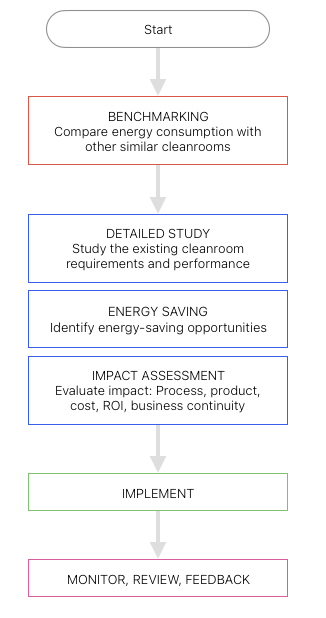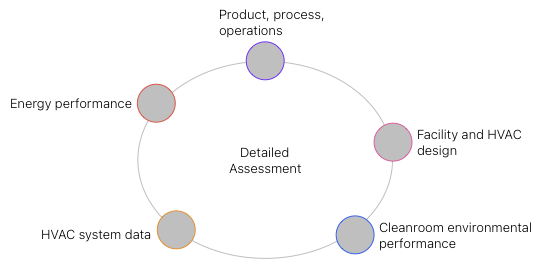ISO 14644-16: Are 50 Pages Worth $500,000 of Energy Savings?
ISO standards are usually a dry read, full of generalities with a few specifics — and open to different interpretations. An encounter with a typical ISO standard can easily drain your energy. But ISO 14644-16 (Energy Efficiency in Cleanrooms and Separative Devices) seems to be a welcome exception. Besides decent depth, it contains enough specific and practical guidance to help you reduce draining of energy from your cleanrooms.
If you are building new cleanrooms or operating existing ones, reading 50-page ISO 14644-16 (and hopefully implementing it) could save you thousands of dollars in energy every year.
Overall, the standard answers the following questions:
- How to reduce energy consumption in a new or existing cleanroom facility?
- What are some of the most promising energy-saving opportunities?
- How do things like User Requirements Specifications, supply air flow rates, filters, garments, facility design, etc. impact the energy profile of a facility?
This post gives you a peep inside ISO 14644-16–and perhaps, you will see the benefits of embracing it, eventually reducing the energy consumption of your facility.
Follow a process
Saving energy in existing facilities is not just a technical challenge. Technically, most facility owners know the potential range of measures to reduce energy. Beyond technical, however, an energy-saving project is about avoiding any adverse impact on the product, process, or business continuity.
So, it’s an undertaking with critical constraints.
No wonder, ISO 14644-16 dedicates a complete section (No. 4) to explaining the step-by-step process for energy reduction in both existing and new cleanrooms. Fig. 1 below shows a simplified process for existing cleanrooms with the following key steps:
- Benchmark
- Conduct detailed assessment
- Identify energy-saving opportunities
- Assess the impact
- Implement
- Monitor, review, and feedback

Let’s dive deeper into the individual steps.
First, benchmark
Energy-saving exercise in an existing cleanroom facility involves considerable costs and resources. Before committing to it, isn’t it good to ask: Where do we stand compared to other similar cleanrooms?
For energy comparison, ISO 14644-16 (Annex D) lists three indicators:
- PICR (Power Intensity for Contamination Removal): Measurement of how much power is consumed by the air handling system (make-up unit, recirculation, exhaust) per square meter of cleanroom floor area. So basically, this is the power input to the fan system divided by the floor area of the cleanroom. (Unit: Kw/m2)
- EICR (Energy Intensity for Contamination removal): Indicates how much energy the air handling unit system consumes over the whole year per square meter of the cleanroom floor area. Looking at annual energy consumption helps you to factor in system setbacks, turndowns, stoppages, etc. (Unit: kWh/m2)
- Energy Intensity (EI): Shows energy use of the heating, cooling, humidification, dehumidification, lighting, etc., over a whole year per square meter of the cleanroom floor area. (Unit: kWh/m2)
Benchmarking may involve some new measurements and data churning from the past, but it is indeed a great way to start the journey. If the above Energy Performance Indicators (ENPIs) show a noteworthy gap between your cleanrooms and similar ones, you have a good reason to move forward to the next step, which is “detailed assessment.”
Second, go for a detailed 360-degree assessment
This is perhaps the most critical step: a detailed assessment of the product and process requirements, design, current cleanroom performance, system operational data, and energy performance.

Basically, it is about answering the following fundamental questions:
- What are the product, process, and operational requirements?
- What’s the current system design?
- What’s the cleanroom environmental performance (particle counts, recovery, temperature, pressure, etc.)?
- How are the current systems (HVAC and others) operating?
- What’s the current energy performance of the facility?
The assessment would, in turn, lead to the most important question: What are the potential energy-saving opportunities?
Identify energy-saving opportunities
Table B.1 in Annex B of ISO 14644-16 provides a comprehensive list of all possible cleanroom energy-saving opportunities. The list covers over 30 opportunities for every stage of a project, from initial conception, URS, and design to testing, operation and maintenance, and decommissioning of a facility.
Here is a curated glimpse of just seven opportunities from that list of 30:
- Avoid over-specifying temperature, humidity, pressures, cleanliness class, etc.
- UDAF: Reduce air velocity
- Non-UDAF airflow: Reduce airflow volume rate
- Turn-down/set-back capability (reduce airflow rate during idle hours)
- AHU and HVAC components: Use high-efficiency components
- Use low-pressure drop filters
- Adaptive control (reduce airflow volume flow rate according to contamination demand)
Identifying the energy-saving opportunities, however, is only half the game. The other half is to assess their impact.
Assess the impact
As mentioned earlier, an energy-saving project in a GMP facility is not just a technical challenge. To be successful, it must make business sense but without adverse impact on the product, process, or business continuity.
Annex C of ISO 14644-16 guides impact assessment, which should essentially cover:
- Process and product impact
- Safety, regulatory impact
- Feasibility of implementation, timeline, and resources needed
- Business continuity
- Cost, ROI, lifecycle cost
Based on the impact assessment, prioritize the energy-saving opportunities. The ones with the maximum energy-saving potential with the least impact should be prioritized.
Next, it’s time for action.
Implement
You can see that implementation comes only after a series of preparatory steps: benchmarking, assessment, identifying opportunities, and impact assessment. Based on the finally selected opportunities, a detailed implementation plan should be prepared and executed.
Monitor, review, and feedback
Upon completion of the project and thereafter at regular intervals, monitor and review the facility’s energy performance. Make adjustments if necessary.
In a nutshell, this is the process of energy saving laid out in ISO14644-16.
What else is there in ISO 14644-16?
First of all, ISO 14644-16 places huge importance on User Requirements Specifications (URS), recommending that URS should indicate the number of people inside the cleanroom, process equipment heat load, acceptable range of temperatures and humidity, garment levels, etc. I don’t know how many people can connect the dots, but the truth is: Many of the initial few decisions taken at the time of writing URS decide the fate of a facility’s energy intensity for decades to come.
The standard emphasizes that instead of designing HVAC systems based on fixed air changes–the traditional way–one should calculate supply air volume based on particle generation rates and ventilation effectiveness. Annex A provides a detailed explanation of such a calculation with an example. It also includes the following insight that goes against the legacy thinking:
“The airborne concentration in a cleanroom depends on the supply air rate and not the air change rate.“
My own experience is that due to the risk of impacting GMP conditions, most biopharma facilities and even new designs are too cautious on the energy front. We continue to follow fixed air changes for different classes of cleanrooms and keep pressing for 0.45+/-20% filter face velocities. Overall, overdesigning and over-performance are quite prevalent. In other words, there are several low-hanging fruits available for reducing energy consumption in biopharma cleanrooms.
The interesting aspect of energy-saving measures is…it’s cumulative. Seemingly small actions (say, reducing the fan speed during unoccupied hours) continue to save energy hour after hour, week after week, and year after year.
If you’re designing new biopharma cleanrooms or operating an existing one, ISO 14644-16 is worth your attention even if it drains your own energy a bit. Who knows, a brief review of this 50-page document could trigger a process that eventually leads to sizeable energy savings for your facilities around the world?
hvac-cq.com | Copyright © Atul Mathur 2024
